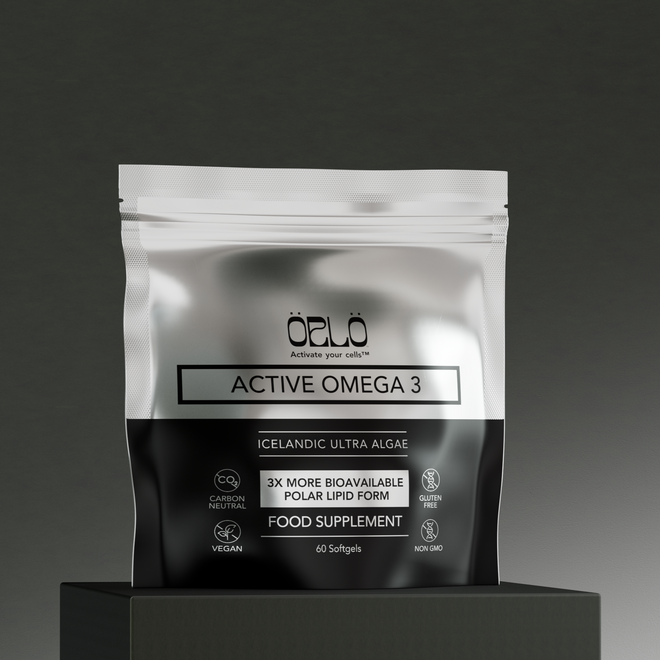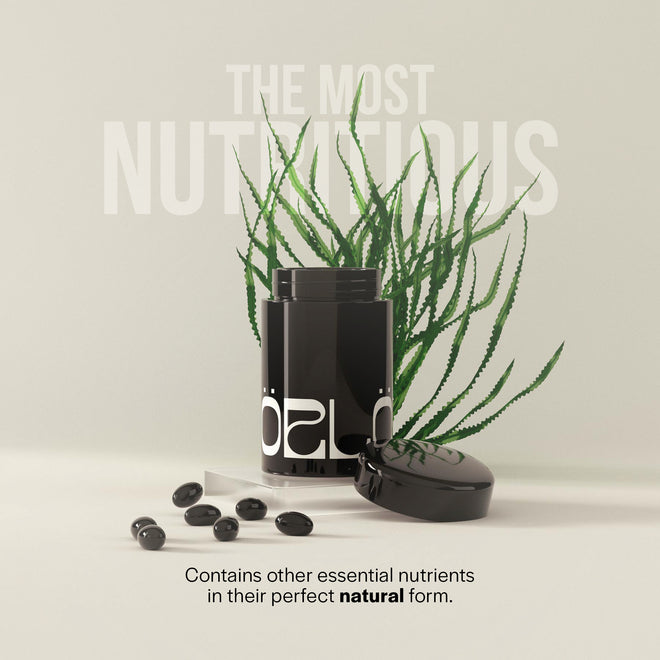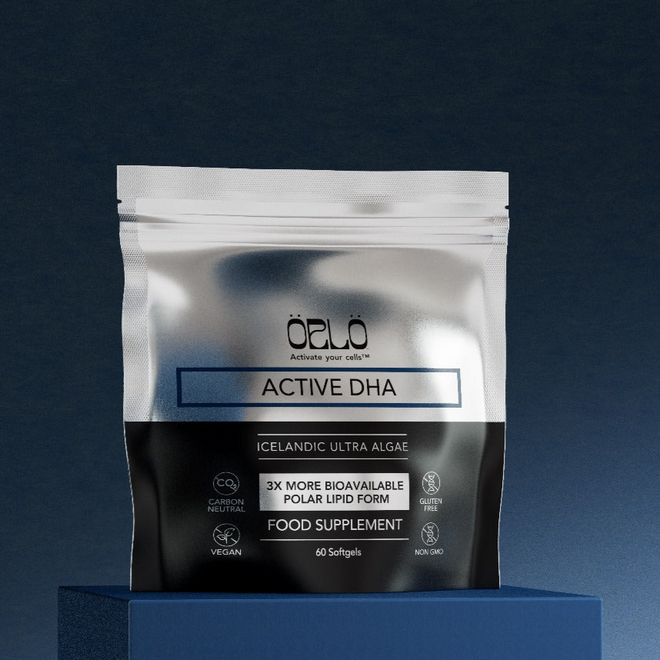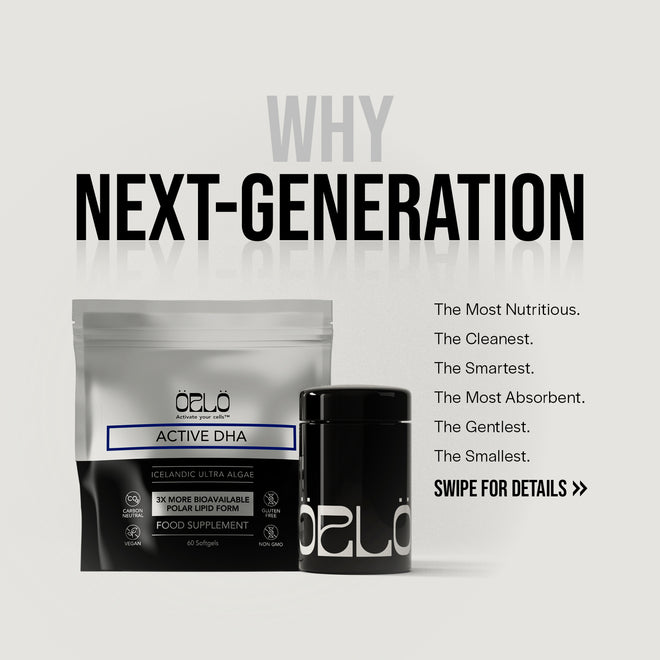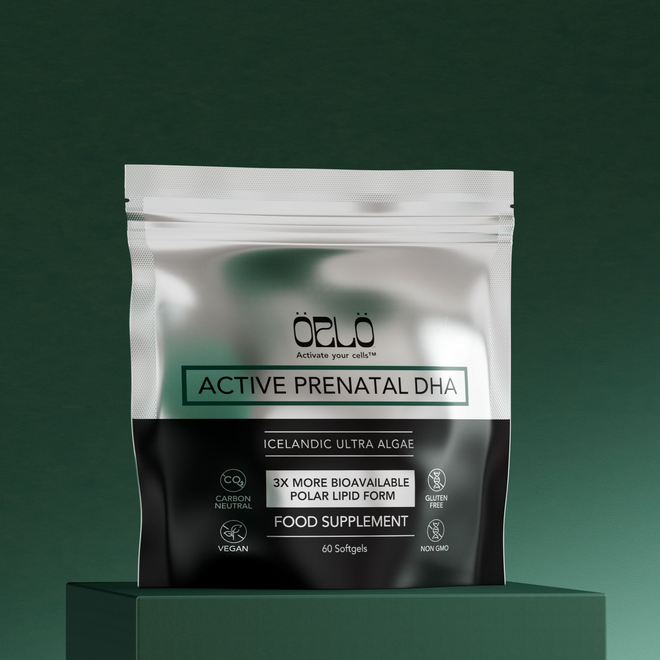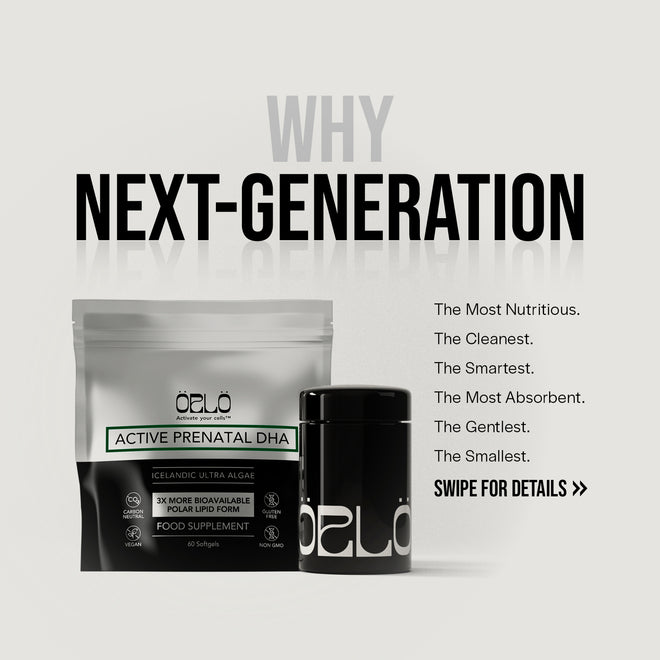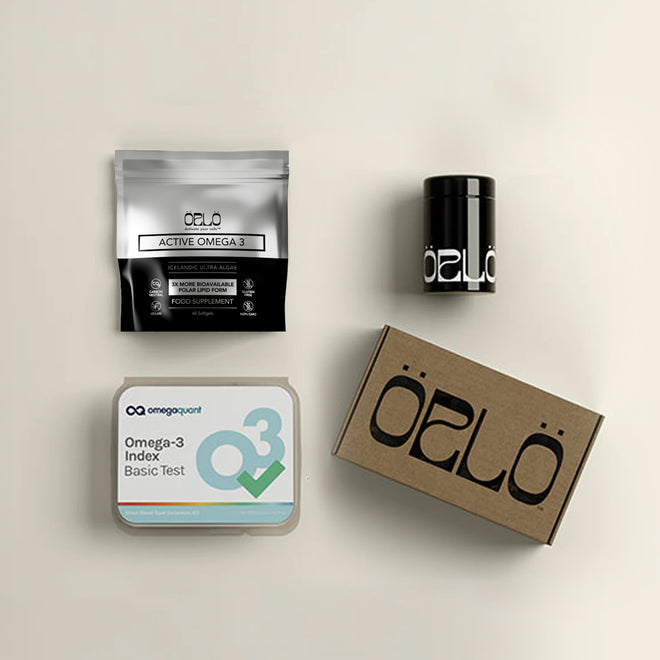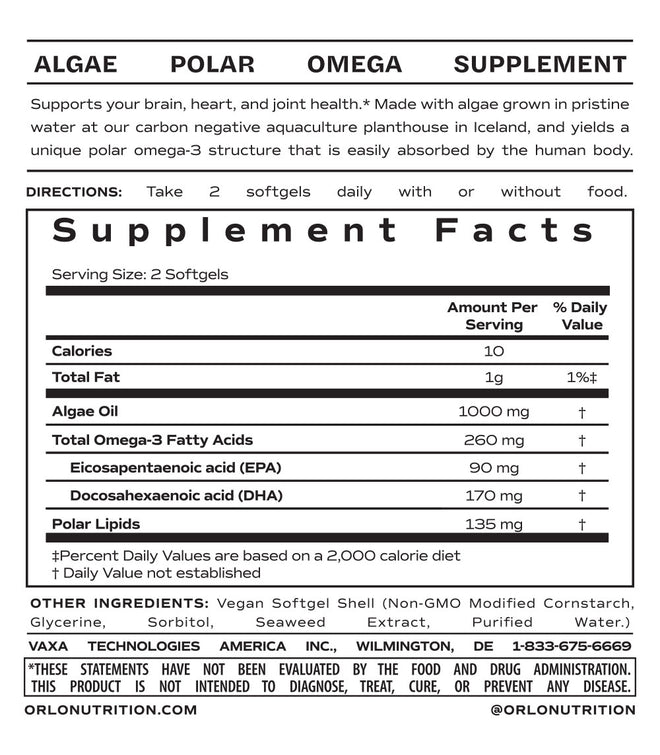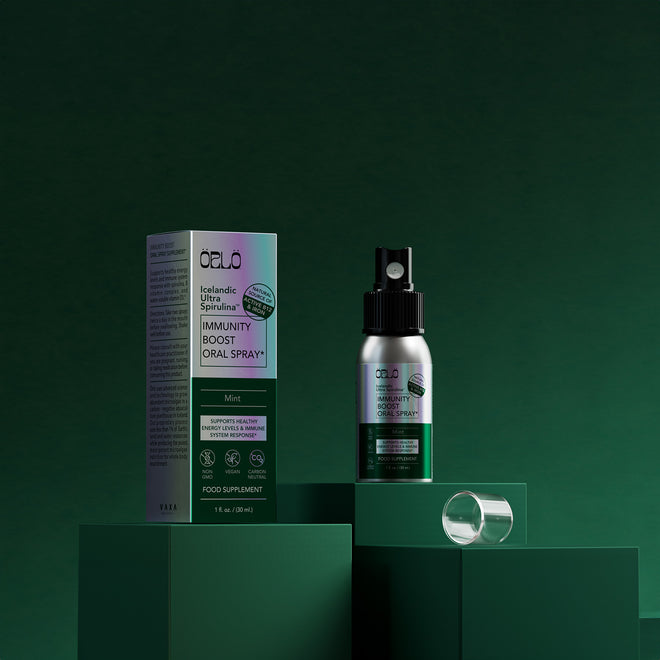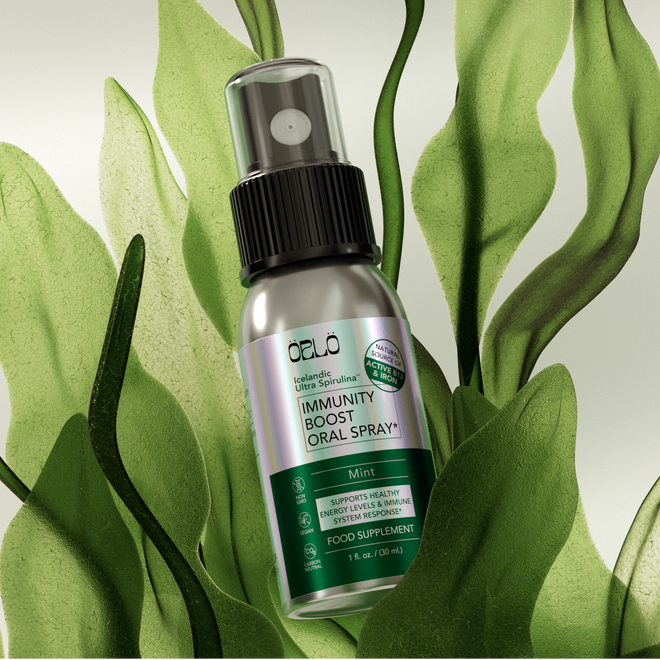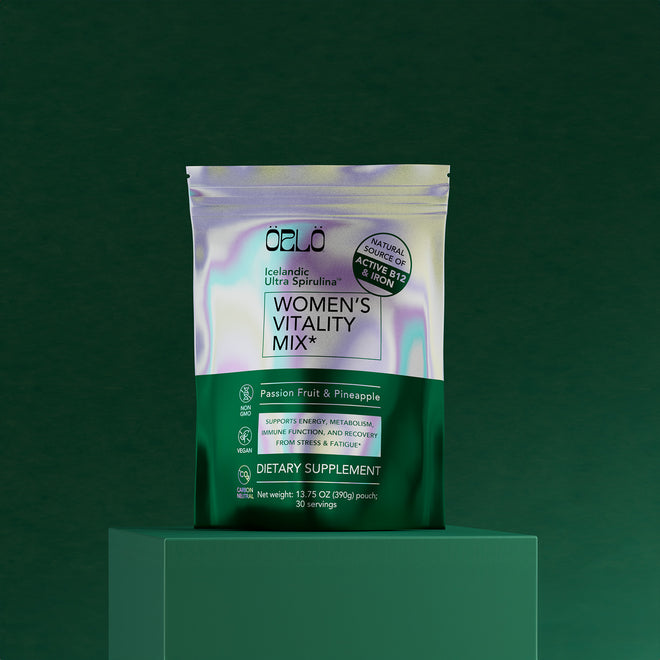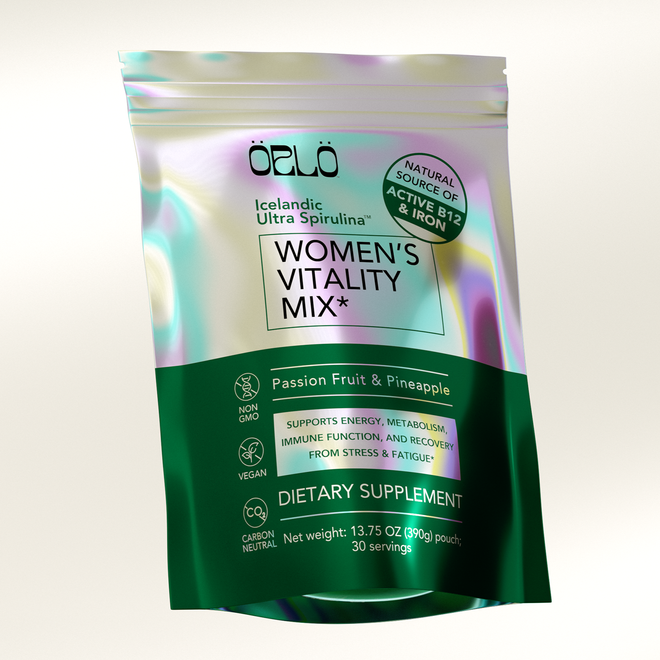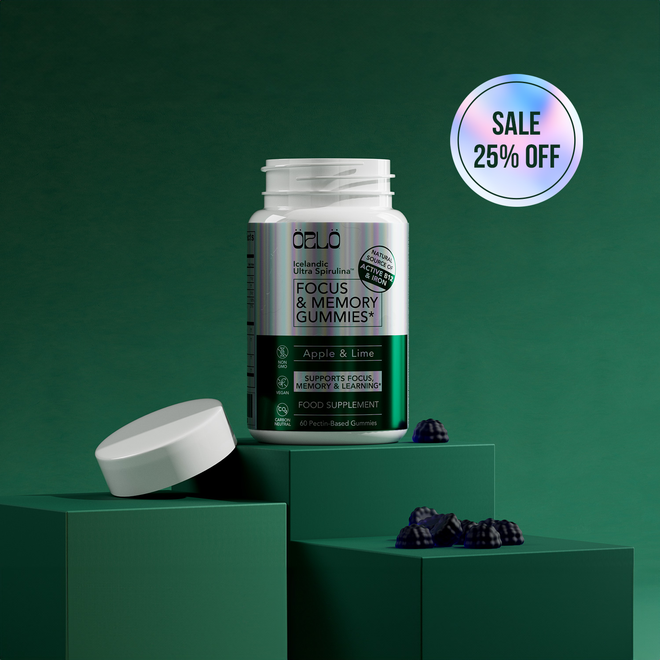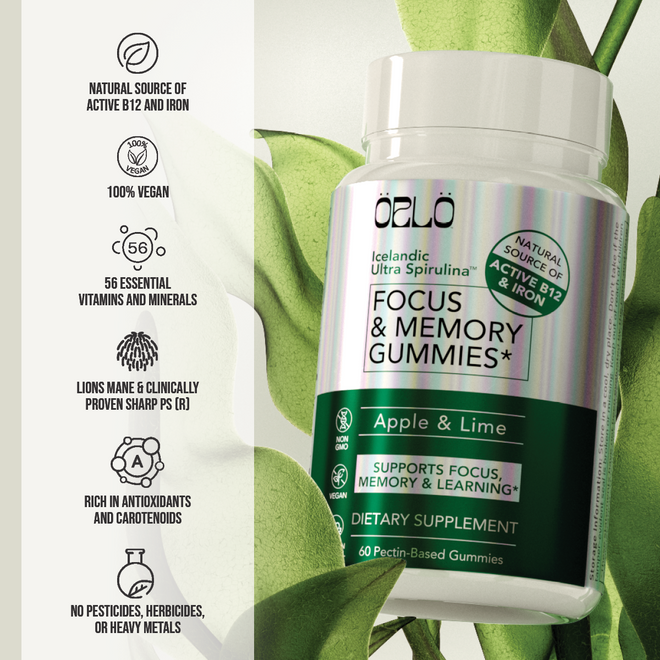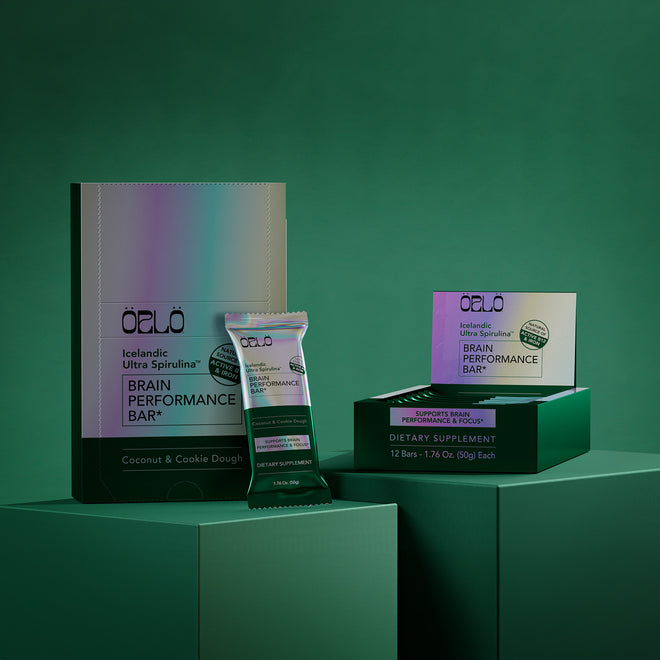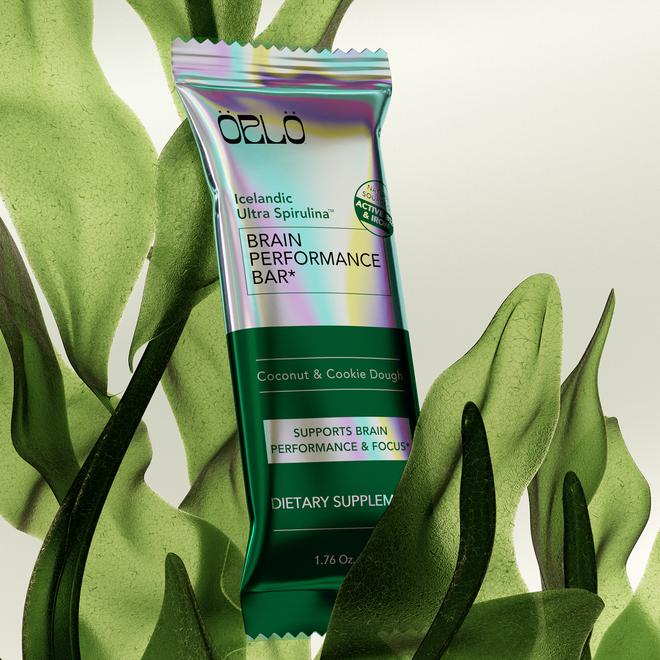25% Off - use code: HOLIDAYS
How To Check If You Are Getting Enough Omega-3 (Free Test Offer Included!) With Dr. Bill Harris
Watch the episode here
Are you getting enough omega-3 fatty acids? If you don’t know how to check, then you are in for a treat! In today’s episode, Corinna Bellizzi interviews none other than an internationally recognized expert on omega-3 fatty acids, Dr. William (Bill) Harris. He is the President and CEO of OmegaQuant Analytics, LLC and the co-inventor of the Omega-3 Index, which has since been used as the standard measure of omega-3 status in more than 200 clinical studies. With his extensive background, Dr. Harris enlightens us about the many benefits of omega-3 along with the reason why people are not consuming enough of it. He then shares how you can make sure that you are getting enough, providing a free test offer to help you check your levels and verify what your omega-3 index truly is. Full of insights that could impact the future of your health, this conversation with Dr. Harris is surely one you won’t want to miss!
Key takeaways from this episode:
- How omega-3 tells you about your future risk for heart disease
- How supplementation can correct insufficiencies
- How to check your omega-3 index
- Benefits of omega-3
- The Framingham Study on omega-3
Guest Social Links:
Website: https://omegaquant.com
Instagram: https://instagram.com/Omega3Index
Twitter: https://twitter.com/OmegaQuant
---
How To Check If You Are Getting Enough Omega-3 (Free Test Offer Included!) With Dr. Bill Harris
In this episode, we’re going to dig into the many reasons that people aren’t consuming enough omega-3 fatty acids and what you can do to make sure that you are getting enough. We’ll talk about how you can also verify that your levels are sufficient to be cardioprotective and protective of your neurological systems, and all cells in your body. We’re going to get to know Dr. Bill Harris.
Dr. Harris is internationally recognized. He’s an expert on omega-3 fatty acids and how they can benefit patients with heart disease. He obtained his PhD in Human Nutrition from the University of Minnesota and did post-doctoral fellowships in clinical nutrition and lipid metabolism with Dr. Bill Connor at the Oregon Health Sciences University. His interest in omega-3 fatty acids began with his postdoctoral work when he published his first study on the effects of salmon oil on serum lipids in humans. That was back in 1980. Since that time, he has been the recipient of five NIH grants for studies on the effects of omega-3 fatty acids, EPA, and DHA on human health.
He has more than 300 publications relating to fatty acids, including omega-3s in the medical literature. He was the author of two American Heart Association scientific statements on fatty acids. The first was Fish Consumption, Fish Oil, Omega-3 Fatty Acids, and Cardiovascular Disease back in 2002. This was when we first began to be able to make a claim about omega-3 specific to cardiovascular health. The other was Omega-6 Fatty Acids and Risk for Cardiovascular Disease back in 2009. Both are published in the Circulation Journal. Dr. Harris co-invented the Omega-3 Index in 2004 and made it commercially available to you through a test by OmegaQuant.
We’re going to dig into this and begin to understand how you can check your levels, how you can verify what your omega-3 index truly is, how it relates to total body health and your Omega-3 status, and ultimately, what it could mean for your future health. Dr. Harris is also a Professor in the Department of Medicine at the Sanford School of Medicine at the University of South Dakota. He moved on as OmegaQuant’s President in late 2020 to establish the Fatty Acid Research Institute, FARI, where he will go back to his roots of conducting research on fatty acids and health. Dr. Bill Harris, it’s lovely to see you. Welcome to the show.
Thank you. It’s great to be here. It’s great to see you again.
You are doing so much. You have done so much in your illustrious career to helping correct this global omega-3 insufficiency, if not deficiency. First, before we get into the meat of it in the science, let us start by stating a simple disclaimer because I know we’re going to discuss the science. This information is offered for informational, educational, and even entertainment purposes. It’s not meant to treat, diagnose, or cure any of your ailments. If you specifically have a health concern, then you need to be working with a qualified health professional. Anything else to add to that, Dr. Harris?
That’s a great disclaimer.
I have to start with the simplest of questions. Why have you dedicated your entire career to omega-3 research?
I didn’t know I was going to do that as it turns out. It’s never part of the plan. You just keep going on to the next thing, and then the next thing was always the next question with omega-3. As you alluded to, we started in the late ‘70s doing things with salmon oil to see how they affect blood lipid levels, cholesterol, and triglycerides in humans. We then became aware of the Eskimo work of Dyerberg and Bang from Denmark working in Greenland. They were finding out that omega-3s were blood thinning and responsible for reduced risk for heart attacks among Eskimos who were eating diets that would make us cringe for how much fat, saturated fat, and cholesterol they contained. They were eating largely an animal-based diet, seafood, and reindeer.
Almost no fiber.
Fresh fruits and vegetables, forget it. You don’t grow those in Greenland. In any event, there was this conundrum that Dyerberg and Bang pointed out and found that omega-3s were related, and we were getting on the train at the same time on the blood lipid side, not so much the blood thinning part. Although we did get into that. As I say, one thing led to another. We had question after question like, “Why did omega-3s do this? Why did they lower triglycerides? Why did they affect blood platelet aggregation or the stickiness of the platelets? Why do they raise HDL cholesterol levels? Why do they have an effect on LDL cholesterol, the bad cholesterol?”
For those that aren’t schooled in these things, LDL is typically known as the bad cholesterol and HDL is the good cholesterol, which tends to go up if you eat a Mediterranean diet.
In the first twenty years of my career, I was studying, “What’s the effect of giving omega-3 on X, Y, or Z in humans?” In the early 2000s, we come around to how I put on a different hat. We developed these omega-3 index blood tests, and I became more of an epidemiologist in a way, people who study populations and risk factors. Cholesterol’s a risk factor for heart disease, and high blood pressure’s a risk factor. We know what risk factors are.
A colleague of mine in Germany, Dr. Von Schacky, and I came up with the Omega-3 index. We believe it is just as much, if not more, of a risk factor for heart disease than cholesterol is. It tells you a lot about your future risk. I’ve become obsessed with how many diseases does a low omega-3 level predispose you to. On the other hand, having a high omega-3, how does that protect you from diseases A, B, and C? That’s what we’ve been studying ever since probably 2005 to 2010.
Omega-3 is just as much, if not more, of a risk factor for heart disease than cholesterol is. It tells you a lot about your future risk.
As we’re thinking about this, here is one of the ways in which you’ve helped educate people about what a proper blood lipid level might be of omega-3, and what we’re talking about here is the omega-3s getting into your tissue. Your test verifies the level of omega-3s that are present in people’s cell walls, like in their blood cells.
We know that, for instance, there are some blue zones around the globe where people tend to be healthier. I remember when I took my first omega-3 index test. It was probably back in about the time that you launched, relatively closely after that. I learned taking an omega-3 supplement every day and also consuming fish. One of my favorite meals at the time was sushi. I would eat a lot of raw fish or get local wild fish and cook that in my own home. I consume a Mediterranean diet mostly. These days, less on the meat side, but pretty similar to what you would expect people in a blue zone to have. Sure enough, I think I was at the high end of 7%, almost 8%, so pretty good.
Very good.
I don’t know where I am now, but if we’re to scale this to help people understand what would be healthy and unhealthy, what is typical of what we see in Americans, and what is typical of what we might see in vegans. I’d love you to answer those two questions.
To back up and rephrase what you said, the Omega-3 index blood test is a measure of how much EPA DHA is, so the two marine omega-3 fatty acids. How much EPA and DHA are in your red blood cell membranes? The red blood cell is a cell we have lots of. It’s very easy to get access to it, unlike your liver or your brain. We can’t assay that, but we can get red blood cells and we can measure the membrane amount of omega-3. The omega-3s reside in membranes all throughout the body. Every cell type, they’ve all got omega-3. The red blood cell is a good surrogate for that.
We then measure how much EPA and DHA are there as a percent of all the fatty acids in the membrane. There are 28 different ones that we measure. The omega-3s typically constitute between 3% and 10% of the total fatty acids in the membrane, depending on how much EPA and DHA you eat largely. We first published our paper proposing the omega-3 index as a risk factor for heart disease. It was 2004. We proposed a level of 8% or greater looked like the optimal zone. It’s not the average or the normal. It’s the optimal. The average or normal omega-3 index in the US is roughly somewhere in the 5% area.
We haven’t studied that many vegans, but in the one study we did, they were roughly 3.5%, which is pretty low. We also did some studies on US Army personnel when they were deployed in Iraq. They had the same omega-3 index level as vegans. It’s not because they were eating a vegan diet, I’ll tell you that. They were eating whatever army rations were being fed to them, which is terrible that it should be that low in people whose mental capacity needs to be very sharp. Anyway, that’s a little rabbit trail.
Is there a population that has an optimal omega-3 level? Yes, there is. South Korea and Japan are pretty much certainly where people are eating the traditional diet. With the younger generation that’s moving more toward American diets, their omega-3 index is dropping because their intake of fish is dropping. That’s unfortunate, but the levels we aim for this 8% is something that can be achieved with fish. It’s not impossible. It’s not a physiologically irrelevant level. Although, the problem is most people won’t eat that much fish or the right kind of fish in America particularly.
Especially with the present trend to go more plant-based, and I’m in this realm as well. For years, I worked in the fish well space and got to a place where I no longer felt comfortable supporting mass commercial fishing practices. I’ve made the transition to mostly plant-based sources of my omega-3s. When you do that, it’s very challenging to get enough EPA and DHA because you can’t necessarily make EPA and DHA from these terrestrial sources like chia seeds or flax seeds. Even if you have a very good diet without supplementation of a vegan omega-3, like from algae, where fish get the omega-3s they have from the algae where they bioaccumulate anyway, if you’re able to take enough of an algae-based omega-3, you can correct for that insufficiency.
I have never seen a vegan test out positively so far as their omega-3 index is concerned without supplementation. This one quick piece of the puzzle fits together. I interviewed Dr. Joel Fuhrman on this show, and he mentioned conducting a study using your blood spot test. The results that came out of it, if I’m quoting him correctly, it’s something like 95% of the vegans they tested was under 5%, and of that 75% were under 3.5%
Very similar. Dr. Fuhrman was part of that study.
I don’t know if I’m quoting them exactly right. I would encourage people to go back and read that episode. It’s so deficient. They’re baseline omega-3 levels. The types of health complaints you see come up in a vegan who’s been a long-term vegan was dry skin, itchy scalp, and sometimes they even experience hair loss. In some cases, that’s related to the proteins, but they could also have so much of an insufficient supply of these omega-3s that their systems start to break down. Your cells are designed to have a balance of these fats in them, and if they’re not there, you’re using whatever is there to create your cell membranes.
When you think about the vegan world, it was on a podcast with a gentleman from India, and you get an entire subcontinent that’s vegetarian, largely. Some subset of that is vegan. There are some milk, egg, and cheese that’s eaten. At least they’re animal products. They can contain a whisper of omega-3. The plants don’t. I’ve never seen a good study in India to see what the average population omega-3 index is, but I’ll bet you it’s in the toilet.
They could correct for some of that with supplementation.
They certainly could.
I remember going to ISSFAL in Maastricht, Holland back in 2010. This is the International Society for the Study of Fatty Acids and Lipids. What most of the researchers there would say anytime the question came up about health isn’t related to body weight and metabolism is consuming saturated fat is not a problem. We don’t care about that. It’s activity level. They would also say, “As long as you’re getting enough omega-3.”
These two things become related because if all you have in your system is saturated fats, and then plenty of omega-6s that come from plant seed oils that are abundant in your diet, then you’re making cells from them. Your cardioprotective benefits might falter because you’re eating processed foods that could also have trans fats in them and other culprits that could damage your health. What is it that you’re seeing? What’s the perfect answer? Do you have one?
We try to focus on the perfect answer for perfect health is beyond me. I’ll stay in the field that I know, and I know that having a high or optimal omega-3 index, somewhere between 8% and 12%, is a great thing that you can do. It’s definitely under each individual’s control. They can get their omega-3 index there by supplementing or eating more fish as their diet allows. That’s the best thing to do.
I try not to get distracted by other concerns. I’m not that worried about omega-6 fatty acids. There’s pretty good evidence that omega-6 linoleic acid is pretty healthy. It’s good for us. I don’t get on that omega-6 and omega-3 ratio bandwagon particularly. I’m more concerned about people getting the EPA and DHA levels high. I’m not worried about a ratio for a variety of reasons. We can go into that if you’d like.
We should because I’m also reminded of a dinner debate at that ISSFAL. Were you there?
I was the debater.
Yes, along with Bill Lands and a few others.
I think it was Chris Ramsden. He was primarily the one, but he was representing Bill Lands and Joe Hibbeln.
The question was posed. You’re basically asked to debate that omega-6s were good for heart health.
Fundamentally, that’s it.
The audience, and I was in the audience, was surprised to see how much research backs up the consumption of vegetable-based omega-6s to support heart health.
There’s better data now than there was in 2010.
There’s evidence there. Villainizing an entire class of fats, which are also essential fatty acids isn’t necessarily the answer. We do want to go ahead and increase our consumption of omega-3s because we aren’t getting enough, and they’re so vital to cellular signaling. Half the fat in our brains and eyes is made up of DHA, so it makes sense. Less of the bad, the bad are trans fats and processed foods.
If you’re talking about less bad, let’s take the processed foods out and follow some of the recommendations we might get from the Dr. Joel Fuhrmans of the world who says, “Eat mostly plants or a plant-based diet, but a wide variety of foods, and don’t eat processed foods at all.” That’s his whole bandwagon. He says, “Not even olive oil.” That might be extreme for people, but he’s trying to break bad habits and change people’s rules. We’ve come to a point where we’re so likely to grab the easy solution. The easy bar-in-a-bag type thing is not going to produce long-term health outcomes for people. Doctors like him are seeing that in practice, so sometimes extreme measures are needed.
You and I were having a conversation before we started this. I’m a consumer of omega-3 supplements, I have been for a long time, but I also recently stopped eating as much fish. I still do from time to time. I’ve been a little wary of taking a test to see where I sit. I’m committing to take a new omega-3 blood spot test and see where I sit to get my new baseline so I can see if I need to increase my levels with a real fundamental result as opposed to a pipe dream, a thought, or a whisper. Measuring is important to manage health. What do you typically recommend people do when they first get an omega-3 blood spot test? When do they retest? What is your ideal?
When people first order tests and it arrives in the mail in a little bag, open it up and do it right away. Don’t delay. Don’t think, “I know I’ve not been good. I probably need to up my omega-3 supplementation for a while because I know I’m not going to have a good score. I’ll wait and do it then.” Don’t do it then. Do it right away because you need a good baseline.

You’re about to embark on an omega-3 supplementation regimen and you want to know how much it affects you. You can’t tell if you don’t know where you start. Even if you start low, welcome to America. This is where almost everybody’s low. Don’t feel like you should wait to do it. Do it right away. After about 3 to 4 months of supplementation, do another test and see where you’re at. Everybody responds differently to a fixed dose of omega-3 supplementation.
I do want to share with all of our audience here that we are getting ready to launch a campaign in collaboration with OmegaQuant. We have such belief and faith in our product. We’re presently doing a comparative study between our omega-3s from algae, which are in the polar lipid form, and comparing it to an equal dose of an omega-3 from fish oil balanced for EPA and DHA with that same kind of construct.
We’re in the middle of that study, but we didn’t want to wait to bring these results to our audience. What we’re getting ready to do is provide a test free of charge to new subscribers of Örlö Nutrition. You can go to our website and subscribe for our two-month supply of omega-3 DHA or prenatal DHA. We’re agnostic. It can be whichever product you prefer. You’ll receive your two-month supply at our standard subscription rate, which is 15% off of the list. It ultimately means that you get a couple of months’ supply for less than a dollar a day, but you’re going to get your omega-3 blood spot test for free. This is a $50 value.
It basically means we’re mailing you $50. We want you to take the test to get your baseline on day zero. As soon as it arrives, take the test, fill out the card, register online, and send it in. With your third shipment, which will contain your 5th and 6th month, you’re going to get another test to verify your results. That second test can then be sent to OmegaQuant. You’ll get your results in between 2 and 4 weeks, sometimes even less.
We usually say five days after we receive it in the lab, the results are ready.
That’s pretty quick.
A week at the most, I would think.
That gets sent back to your inbox via email right away, and you’ll see where you sit from that 3.5% on the bad side up to 12% on the high end.
We have some of the highest ones we’ve seen, and maybe it would be 15%. We don’t really have any way to judge whether being at 15% is any better than being at 10%. There’s so little research on that very extreme level of omega-3 levels. You can’t tell. One thing I want to say about the test is to open it up and do it right away. You don’t have to be fasting overnight to do this test.
Anytime day or night. It’s not sensitive because it’s not related to your blood what you just ate, for instance. This is also something we need to clarify for people when it comes to any fat-soluble nutrient you might be testing for. It takes time for your body to change. Much like when I go to get my thyroid checked, my doctor says, “We adjusted your prescription so we’ll check you again in 3 or 6 months.” They want to see that I’m continuing to take something over that long period of time. They’ll say the same thing about vitamin D, “You’re a little low. I’d like you to start taking a couple of thousand IU of vitamin D a day and we’ll check you again and six months.” It can take time to get that shift to happen in your tissues.
I may never see it, but I’m dreaming of the day when the doctor, in addition to saying, “You’re a little low in your vitamin D,” also says, “You’re a little low in your omega-3. You need to start taking more.” It’s got to be in the doctor’s office like vitamin D.
I think it will come after there’s an RDI or a Recommended Daily Intake of omega-3.
That’s another story to talk about.
We’ve been pushing for that for a long time. I know GOED, the Global Organization for EPA and DHA, was very hopeful a few years back that we would get at least a baseline recommendation of a couple of hundred milligrams of EPA and DHA a day. That didn’t happen. Where are we in that?
When you talk to people about why isn’t there one, there are a lot of excuses. One of them is that EPA and DHA are not strictly essential nutrients for a human. It’s because you can live, grow, reproduce, and live a full life without eating any EPA and DHA. That is a vegan. Look at India, they’re there. They’re making babies. They’re living. Some of them are not eating any EPA and DHA. You can’t say in the classical sense it’s an essential nutrient.
They say in a classical sense that omega-3 fatty acids, meaning alpha-linolenic acid, are essential.
Alpha-linolenic acid, there’s an RDI or I think it’s an average daily intake, but 1,600 milligrams a day of ALA is recommended. They feel like, “We’re done with omega-3s. All we got to do is recommend.” They’re not consistent. Part of the problem is to say you don’t make recommendations for anything that’s not an essential nutrient is disingenuous because they have RDIs for saturated fat, cholesterol, and fiber, none of which are essential nutrients. Still, there they are with the recommended dietary intake. I’m not sure why it’s not happening. I know there’s something to do with money. It costs a lot of money to evaluate a new nutrient or a new food component for a recommendation.
I was hopeful they would come up with something back in the day when they were making the first fish oil drug, Omacor. That didn’t happen then either. Have to figure out a way to convince the government that it’s that important or make it a moneymaking enterprise for them.
That’s a political fight more than a scientific fight, I’m afraid.
Most people and the medical community as a whole will associate things like HDL level, LDL, homocysteine, C-reactive protein, and things like that with heart health. If you could comment on where you think the omega-3 index stacks up against all these other markers, what would you have to say, especially if there are doctors reading?
From our published research, the Omega-3 Index adds additional information in terms of risk prediction above and beyond any of those nutrients or any of those markers, HDL cholesterol, LDL, blood pressure, diabetes, smoking, or homocysteine. Knowing the Omega-3 Index gives you additional information that don’t have that you don’t predict as well. There are risk factors to be able to predict your risk for cardiovascular events or cancer. It’s at least as good at those other things that are predicting who is going to be having a heart attack in the next ten years. If you can add it to those other markers, all the better.

I believe I heard you guesting on another show where you spoke about the fact that heart disease can be a silent killer. People don’t know they have a heart health problem, especially women, until the event or the infarction. Do you believe that this test can reliably provide an indicator for someone who might not otherwise routinely check their cholesterol levels or blood pressure, etc.?
Yes. I don’t want to imply that you shouldn’t have your blood pressure checked or you shouldn’t check your cholesterol level. You should do everything. You should do your omega-3 level and you should check these classical risk factors for heart disease. Do everything you can do. Optimize all of them. That’s the most logical thing to do. It’s just that omega-3 has been left out of that equation for far too long. We’re writing a paper now asking that very question, “To what extent does having information on the Omega-3 Index improve your ability to predict who has a heart attack above these other risk factors?” It does, significantly.
What people don’t realize is the gorilla in the room of predicting your risk for heart attacks is your age and sex. You can’t do anything about that. That’s a fixed 70% of the predictive power of who’s going to have a heart attack and not. It has to do with age and sex. You then add on these other little things like cholesterol, blood pressure, diabetes, and smoking. It increases it a little bit more. It’s remarkable that almost all the water’s being carried by age and sex in terms of predicting your risk. The omega-3 helps.
What people don’t realize is the gorilla in the room of predicting your risk for heart attacks is your age and sex.
That’s not necessarily the worst news in a way because at least then, you’re essentially saying to people, “If you’re a menopausal woman, you might want to get your omega-3 levels checked. If you’re in your late 40s as a man, you might want to get this checked along with the blood panel that you see from your doctor every year. If you haven’t gone to your doctor this year, you might want to and at least get these things checked.” I am the one who has to remind my husband to go. He’ll let it fall off. He feels fine. Nothing’s going to go wrong. I’m like, “I get my annual in January, and so do you.”
That’s right. Keep on him. That’s another thing. You can’t feel when you have an omega-3 deficiency. It’s not like a classic vitamin C deficiency where your teeth fall out and have scurvy. It’s a much more subtle thing. It’s very much like you are not going to have optimal health. The analogy of people is to throw around having the right omega-3 indexes, like having the right amount of oil in your engine. It just makes it run more smoothly. Not that the omega-3s lubricate anything per se in the same sense as the engine oil does, but that analogy or metaphor works pretty well.
There are so many compounding issues that can make you feel low energy or lack focus. Omega-3s might play a part in that, but if you also aren’t sleeping enough and you’re not getting enough water, then what’s causing the problem? You’re right. You don’t necessarily know. It’s not like you can take a litmus test and stick it to your skin and go, “I got enough omega-3.” We’re not there yet.
I wish we had a test like that. That would be great. It’s important to remember that there are some things you can do about your health and some things you can’t do anything about. Your genes, your sex, and your age, you can’t do anything about it. Do everything else that you can control. Omega-3 is certainly one of the main things you can control.
I do want to also point out something that came up in an earlier episode. I was talking to a chiropractor. That’s Dr. Forrest Sauer. I was talking to him about test costs. What he finds is that often the test costs, through your medical system, can be more expensive than they are if you go direct to somebody like OmegaQuant. This is one of those things that blows my mind because it’s happened to me before in my prior insurance. When I was in a PPO, I would get my labs done and it would cost me $160 out of pocket to do some basic tests that I thought should be included. I’ve since shifted to an HMO plan, and now, I only pay a very small copay, but some of the tests aren’t covered.
I have to then advocate for myself and ask for an estimate for the tests that I want to do. What I’ve found is that if I have my omega-3 panel done through the doctor’s office, I’m paying an extra $100. If I have my omega-3 panel with the same results, the same as your index basic test, and I go direct to you, I’m paying $49.95. It’s not always savings to go through your insurance, which is yet another impedance for people to get these tests done.
We have to take a little bit of charge of our health. For instance, if I want to test my vitamin D, my ferritin, or my iron levels, I do those over the counter. I take them myself. I don’t pay very much for them. They’re available at my local drugstore. If I want to take the OmegaQuant blood spot test, it can come to you for $50, and get it done. You will have it in your hands five days after you receive it.
We’re covering that with Örlö for our subscribers. All new subscribers get the first test for their baseline with their first shipment. With their third shipment, which includes the fifth month, they get another one that’s $100. We’re taking care of that for you. It’s a no-brainer. I’m going to send mine in just because I’d like to know what my non-baseline and baseline is.
Do we get to watch you prick your finger? You could do the whole thing right now.
Here’s the test. I’m going to open it up. Why not?
You don’t have to.
You ship it with these two little lancets. It’s an actuated tip. When I push on it, it’s going to prick my finger, but I better get the rest ready. I’m supposed to go ahead and break out the Band-Aids, the alcohol swab, and my test card. I have the test card here. I’m going to put three dots of blood. They’re protected under the flap. That’s where those go. I have my name, date of birth, collection date, and email address for the results to come to me. I’ve got a unique barcode. I’m going to write that barcode down on the test form so that I’m sure I have that as a reference. I’ll keep a copy of that for my records. I got a sterile gauze pad. I’ve got my alcohol prep. I’ll clean my finger first.
Good. Don’t just lick it. You should clean it.
I have two young boys. Who knows what could be in my office here? The older one, I’ve taught to swallow his omega-3 pills, so he’s taking these every day. Our soft gels are only 500 milligrams a piece, so they’re easy to take. They gave us 2 Band-Aids and 2 lancets.
Just in case.
It’s always surprising. The instructions are you don’t milk your finger, you just let it drop. That’s why you give two lances.
That’s the instruction. That’s true.
It’s not like I had to fill the whole thing. That’s not too bad. I’ve got my overall here, Band-Aid, and everything. That was quite painless. We’ll see what Corinna Bellizzi’s levels are supplementing, but not eating fish. That will be an interesting journey because it’s been about three months of not eating fish at this point.
The one thing that we’ll hear anecdotally about people who are taking omega-3 when doctors were prescribing it for high triglyceride levels is that’s what the drug omega-3 is used for. You can’t feel a high triglyceride, but they’d feel like their shoulders don’t ache as much, their knees feel better, and their joints seem to feel better when they were taking omega-3. Even that was not the reason they were taking it.
I noticed a couple of things that are also not typical. I noticed better night vision. If I am not taking my omega-3 for a little bit, it feels like I’m getting more glare from people’s headlights. Secondarily, I also tend to notice that I feel a little bit less connected to my gut. There’s one other that I’m not sure if it’s related to fasting or the omega-3s because sometimes if, for instance, I’m completely off of sugar and I’m continuing to take my omega-3, it’s not like I’m fasting per se, but I’m doing a fast from all processed sugars.
If I still eat other foods that are more whole foods but nothing processed, the floaters in my eyes go away. I was told by doctors it was nothing that could be done about that. I just found it annoying if I look at a big blank wall or something, I see floaters. When I reduce my sugar consumption and I’m consistent with my omega-3s, I don’t notice them.
That’s interesting. I’ve never heard that before.
Anecdotal, I don’t know if there’s any real science to it, but it’s always a combination of the two things. I have to not be eating processed sugar.
It’s an interesting hypothesis to test.
I’ve enjoyed this conversation so much, Bill. I wondered if before we part you could share a little bit with our audience about the research that you’re excited about and this next chapter of your research life with FARI.
The things I’m excited about, and one I’ve already alluded to, is trying to get a feel if doctors are feeling it’s important to measure cholesterol in their patients. They do that for a reason. If I can show you more information about a person’s future health than measuring cholesterol, then don’t stop measuring cholesterol. Start measuring omega-3 too. We need to give people a perspective on the value of it. That needs to be done scientifically using data from Framingham’s study, which is what we’re doing in this trial.
Another thing I’m interested in is if you have certain genetic makeup related to APOE. Do you need more omega-3 for brain health than if you have a different APOE makeup? There may be something you said that you talked to Melanie about that or animal work. There’s evidence in humans too that people with the E4 genotype need more omega-3 in their diet for better brain health.

I took it as serendipitous because I know that my grandmother had Alzheimer’s and Parkinson’s later in life. She passed in her early 70s, and it wasn’t pretty. I know she didn’t eat a lot of fish throughout her life as an Italian. We like to eat our pasta and sausage. It’s not the Italian from Italy. It’s the Italian from the East Coast.
I have a more Mediterranean diet than she ever did. I don’t think that she was set up for success in that way. Since I learned that I have one representation of APOE4, I have felt that it’s somewhat serendipitous perhaps that I ended up working in this polar lipid space as opposed to just a standard triglyceride. Who knows? I might’ve had a difficult time getting enough of it into my brain and eyes as well. I seem to do okay with a very high dose of fish oil, but I don’t seem to need as much to feel as good taking this. We’ll see how that fairs out. I will share the test results.
Another thing we’re interested in is we’re seeing that there’s a relationship between omega-3 levels and hearing loss. Here’s another sensory organ housed in the brain, essentially a piece of the brain as well. Why wouldn’t omega-3 have an effect on hearing as well? So many older people have hearing problems. Is there something omega-3 could do with that? We can just look at population stuff and see relationships if they suggest intervention studies that could be done.
You can reliably do test hearing. That makes for a very interesting study. I know I’ve done some of those apps that are testing your hearing on your phone and telling you at what point most 30-year-olds stop hearing. I’ve taken some of these online tests where you use an app, and it’s saying, “Most 30-year-olds stop hearing this sound by this point,” and changes pitch. I’ve always had a very active sense of smell and hearing. I find that I still perform pretty well, but I’m a use case of one. I’d be very curious to see what these results pan out to show.
Anyway, we’re still having fun.
Areas of emerging research are keeping a view on that. The Framingham study, can you tell us a little bit about that? I’ve covered it a bit on this show. Why do you think it’s such an important study?
Framingham is the name of a suburb of Boston. It was the first effort at real population epidemiology. It started in 1948 with the first recruitment of 4,000 or 5,000 randomly picked people from this one suburb of Boston. The intent was, “We’re going to measure everything we can measure in these people with their diet and history. We’re going to do blood tests up the yin and yang, and then we’re going to follow them. We’re not going to tell them to change anything. We’re just going to follow them over time and see who develops what disease.” They’re trying to discover a term that had not existed before called risk factors.
It was the Framingham study that showed us for the first time that smoking was a risk factor for heart disease and high blood pressure. Men in their 30s, 40s, and 50s were dropping over dead in their late 40s and their early 50s from heart attacks. People thought, “Bad genes. I don’t know what causes this thing.” The Framingham studies started connecting the dots. “The people who are having these early heart attacks have high blood pressure or they have high cholesterol.” That’s the Framingham study. Those people are all pretty much dead now.
We did a study on the children of the first cohort called the Offspring Cohort, a group of people. It was around 4,000 when it started in the mid-1970s. We measured their omega-3 index about several years ago. We have now been able to connect an omega-3 level pretty much at age 65. It’s about the age of these people when their blood omega-3 was tested. Now, they’re up getting up into their 70s, and so we can follow and say, “Who developed dementia? Who got Alzheimer’s disease? Who had a heart attack?” We can then look at how their omega-3 levels predicted that outcome. Who lived the longest? One of the most important things we’ve found is people who have high omega-3 live longer.
We look at total mortality, cardiovascular mortality, cancer mortality, and then everything else that adds up to being dead. The chances of dying in a fixed window of time are roughly 20% lower if you hit the highest omega-3 level compared to the lowest, no matter what you die of. It’s not just a heart disease thing. That’s an important message. High omega-3 is not just about your heart. It’s about every cell in your body.
37 trillion of your own cells and another 39 of microbiota.
They don’t need omega-3 either. I don’t know what to do with that.
You’ve just encapsulated the reason both you and I have spent our careers working in the space of omega-3s. There’s so much you can do with it. I’m twenty-something years into this endeavor now working in the omega-3 space. You’ve got a few years on me on that front.
You can still catch up. There will be a time when I stop.
I will continue to watch what you do. I’m such an admirer of the research you’ve conducted. Thinking back to those moments in Maastricht, Holland with debates and everything that we have to learn, there’s still so much to know.
There’s a lot to know. It is great talking with you.
It was great talking to you too. Thank you so much, Bill.
---
Remember, we’re doing a short-term promotion for new subscribers. If you subscribe to our omega-3 or DHA products, and that includes our prenatal DHA, you will receive a free OmegaQuant blood spot test with your first shipment. You can test your baseline and figure out where you’re starting from. That’s a $50 value for spending less than $1 a day on your supplement.
We’ll also send in that kit a two-month supply of omega-3 along with a beautiful bottle, a MIRON violet glass bottle. It protects the oil within. You’ll get two pouches to fill into it. This can be safely placed on your counter, in your bathroom, or wherever you so choose, just where you’ll remember to take it. Because they’re in the polar lipid form, you can take them anytime day or night with or without food. It won’t burp back on you. No negative effects.
With your 3rd shipment, which will include your 5th and 6th month supply, you’ll also receive a second OmegaQuant kit. You can send that in to check how your improvement has been scored. You can see at that point, if you need to make an adjustment to your supplementary regime, perhaps consider eating other sources of omega-3 foods and addressing your diet.
We’re only giving these away for a limited time while supplies last. We anticipate sending about 500 customers, so it’s important that you act now. We’re essentially giving you $100 with your subscription. If you’re not ready to subscribe, you can always use the coupon code NWC20 for 20% off your first order. This is a gift to our subscribers of this show.
If you have questions about what we covered or topics that you’d like us to dive deeply into, please reach out via our social channels @OrloNutrition. You can send me an email note directly from OrloNutrition.com. As we close this show, I hope you’ll raise a cup of your favorite beverage with me as I raise mine and say my closing words. Here’s to your health.
Important Links
- Dr. Bill Harris
- Fish Consumption, Fish Oil, Omega-3 Fatty Acids, and Cardiovascular Disease - Article
- Omega-6 Fatty Acids and Risk for Cardiovascular Disease – Article
- OmegaQuant
- Become A Nutritarian To Supercharge Your Immune System And Health With Joel Fuhrman, M.D., The 7x New York Times Bestselling Author Of Super Immunity And Eat For Life – Past Episode
- International Society for the Study of Fatty Acids and Lipids
- Addressing The Root Cause Of Health Issues To Live Your Best Lifestyle With Dr. Forrest Sauer, Functional Medicine Practitioner, Twin Oaks Health – Past Episode
- Offspring Cohort
- @OrloNutrition – Instagram
- https://OrloNutrition.com/products/active-omega-bundle
- https://Youtu.be/mkZao6tcy18
- https://Instagram.com/Omega3Index
- https://Twitter.com/OmegaQuant
About Dr. William Harris
 Dr. Harris is an internationally recognized expert on omega-3 fatty acids and how they can benefit patients with heart disease. He obtained his Ph.D. in Human Nutrition from the University of Minnesota and did post-doctoral fellowships in Clinical Nutrition and Lipid Metabolism with Dr. Bill Connor at the Oregon Health Sciences University.
Dr. Harris is an internationally recognized expert on omega-3 fatty acids and how they can benefit patients with heart disease. He obtained his Ph.D. in Human Nutrition from the University of Minnesota and did post-doctoral fellowships in Clinical Nutrition and Lipid Metabolism with Dr. Bill Connor at the Oregon Health Sciences University.
His interest in omega-3 fatty acids began with his postdoctoral work when he published his first study on the effects of salmon oil on serum lipids in humans (1980). Since that time he has been the recipient of five NIH grants for studies on the effects of omega-3 fatty acids (EPA and DHA) on human health.
He has more than 300 publications relating to fatty acids, including omega-3s, in medical literature and was an author on two American Heart Association scientific statements on fatty acids: “Fish Consumption, Fish Oil, Omega-3 Fatty Acids and Cardiovascular Disease” (2002), and “Omega-6 Fatty Acids and Risk for Cardiovascular Disease” (2009) both published in the journal Circulation.
Dr. Harris co-invented the Omega-3 Index in 2004 and made it commercially available to the research community and the public in 2009. To date, the Omega-3 Index has been used as the standard measure of omega-3 status in more than 200 clinical studies. Dr. Harris is also a Professor in the Department of Medicine in the Sanford School of Medicine at the University of South Dakota.
Dr. Harris moved on as OmegaQuant’s President in late 2020 to establish the Fatty Acid Research Institute (FARI), where he will go back to his roots of conducting research on fatty acids and health.
